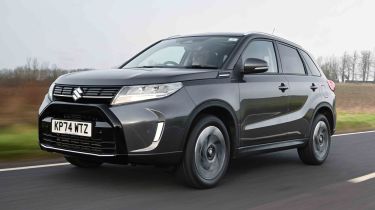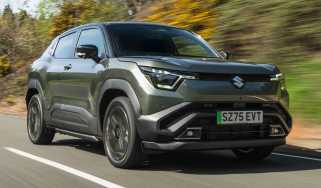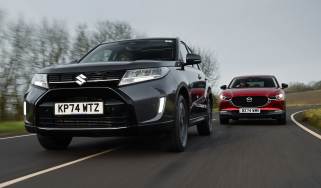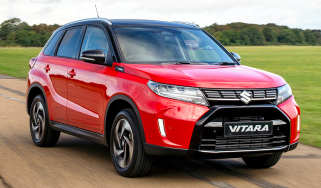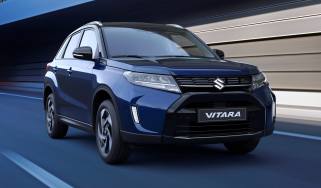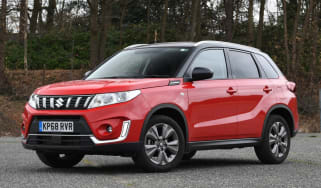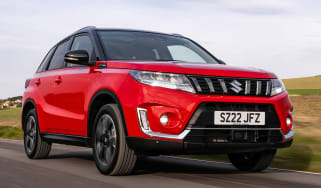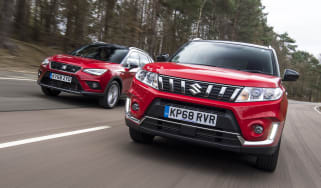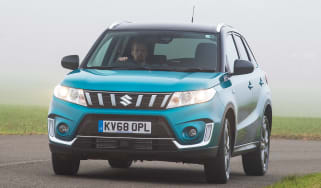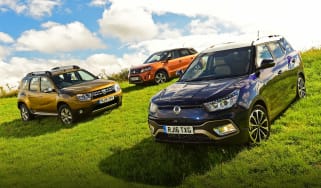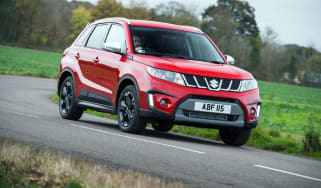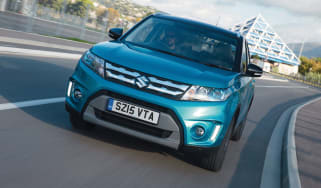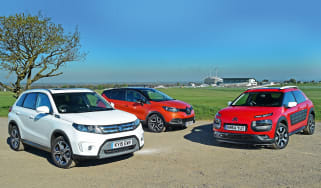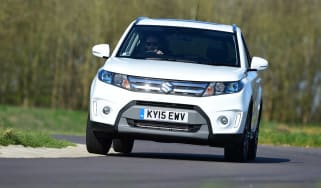Suzuki Vitara review
An SUV in the traditional mould, the Suzuki Vitara is showing its age in some key areas

Our opinion on the Suzuki Vitara
The Suzuki Vitara has been around for a decade now, and it’s really beginning to show its age when you compare it with rivals in the small to medium-sized SUV class. There’s not much wrong with its efficient Boosterjet engines or nimble handling, but the tech on board and general layout aren’t up to the standards of the class leaders these days, while cabin space is only really average. If you need efficient transport that will be a breeze to live with, then it’s worth checking out, although you’ll have to see if you can put up with the touchscreen infotainment and other cabin quirks.
| Key specs | |
| Fuel type | Petrol |
| Body style | Five-door, five-seat compact SUV |
| Powertrain | 1.4-litre, 4cyl, turbocharged petrol plus MHEV, front-wheel drive 1.4-litre, 4cyl, turbocharged petrol plus MHEV, four-wheel drive 1.5-litre, 4cyl, petrol plus 1x electric motor, front wheel drive |
| Safety | Five-star Euro NCAP (2015, expired rating) |
| Warranty | Three years/60,000 miles |
About the Suzuki Vitara
When the fourth-generation Suzuki Vitara first landed in showrooms back in 2015, it marked a sea change for the company’s small SUV. Gone was the ladder-frame construction and focus on off-road ability, in favour of a lighter unibody shell, while front-wheel drive was the most common drivetrain configuration. The changes were designed to boost the Vitara’s appeal to a wider demographic, so that it had the qualities that would allow it to compete with rival small SUVs.
A decade later, the Vitara’s basic structure remains the same, but it has been given regular updates to keep it fresh. The most recent of these introduced a new set of safety systems and a revised trim structure, while the exterior was freshened up with a new grille and wheels. Inside, both trim levels (Motion and Ultra) now feature a nine-inch touchscreen display and wireless smartphone connectivity.
Used - available now

2016 Suzuki
Vitara
26,911 milesAutomaticPetrol1.4L
Cash £13,950
2016 Suzuki
Vitara
66,106 milesAutomaticPetrol1.6L
Cash £9,399
2019 Suzuki
Vitara
38,243 milesManualPetrol1.4L
Cash £10,790
2016 Suzuki
Vitara
36,370 milesManualPetrol1.6L
Cash £8,726Under the bonnet, the engine range has also evolved, and today there is a choice of 1.4 mild hybrid or 1.5 full hybrid powertrains, with the former currently the only version available with Suzuki’s Allgrip four-wheel drive, and the latter being the only automatic in the line-up.
Performance & driving experience
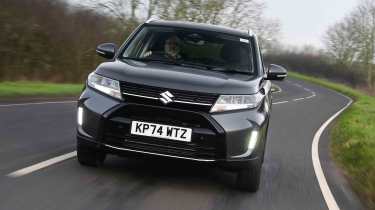
| Pros |
|
| Cons |
|
There are two engine options available in the Vitara. First up is the 1.4-litre Boosterjet turbocharged petrol that was originally introduced to the range in 2020. This features a 48-volt mild-hybrid electrical system with a belt-driven starter generator and is tuned to make 127bhp and 235Nm of torque. It’s connected to a six-speed manual gearbox.
If you want an automatic transmission, then the 1.5 Dualjet comes with a six-speed automated manual. This model foregoes a turbocharger in favour of a full hybrid system, and makes 101bhp and 138Nm of torque in total from its 1.5-litre petrol engine and 33bhp electric motor. In reality, the hybrid system is somewhat lacking, and we’d only recommend it if you must have a Vitara with an automatic gearbox – there are plenty of rivals with far better boxes and hybrid systems.
One advantage that the Vitara holds over competitors is that it’s one of the few small SUVs that’s available with four-wheel drive. Suzuki’s Allgrip system can be had with the Boosterjet engine on top-spec Ultra cars for £1,800 extra. It was once offered with the hybrid powertrain as well, but this combination is no longer available on a new car.
Performance, 0-60mph acceleration and top speed
Performance across the Vitara range is modest, with the fastest-accelerating version being the 1.4 Boosterjet, which can get from 0-62mph in 9.5 seconds. Adding Allgrip four-wheel drive sees that time increase to 10.2 seconds. The hybrid is slower still, managing 0-62mph in 12.7 seconds, while the four-wheel-drive version (which is no longer offered on a new car) sees the sprint covered in a lethargic 13.5 seconds. Top speeds range from 111mph to 118mph.
Town driving, visibility and parking
The Vitara’s upright proportions mean you sit relatively high, so there’s a good view of your surroundings as a result. There’s a rear parking camera fitted as standard on both trims, while Ultra models add front parking sensors to the rear ones that Motion models come with. Light steering means low-speed manoeuvres are a doddle, while the 1.4 offers quick responses.
There’s a slight disconnect between engine revs and forward motion as the electrical system cuts in to offer assistance, but you soon get used to that. The ride in town is a little choppy over bumpy surfaces, though.
B-road driving and handling
At higher speeds, the Vitara smooths out, while the car’s relatively low weight means it feels surprisingly nimble for a chunky-looking small SUV. The steering and gearshift are light but positive, while the chassis offers reasonable grip, too, without an excess of body roll in corners – it’s more like a supermini than an SUV in that regard.
The engine has a revvy nature and makes its peak power at 5,500rpm, so you need to work it hard to make good progress – but it can get a little harsh when you do that.
Motorway driving and long-distance comfort
At the national speed limit, the 1.4 Boosterjet is turning over at 2,250rpm in sixth gear, so there’s a constant hum from under the bonnet. Apart from that, the Vitara makes for a fairly pleasant cruiser.
“A kerbweight of less than 1,300kg helps the Vitara deliver nimble handling and make the most of the free-revving 1.4-litre engine’s power. In a class where many rivals offer safe yet dull handling, Suzuki shows it’s possible to make a small SUV that feels fun on the road.” – Dean Gibson, senior test editor, tested the 2025 Suzuki Vitara against the Mazda CX-30 in a twin test
| Model | Power | 0-60mph | Top speed |
| 1.4 Boosterjet | 127bhp | 9.5s | 118mph |
| 1.4 Boosterjet Allgrip | 127bhp | 10.2s | 118mph |
| 1.5 Hybrid auto | 101bhp (petrol engine + 33bhp e-motor) | 12.7s | 111mph |
MPG & running costs
| Pros |
|
| Cons |
|
The Vitara has always offered good value for money, and that continues with the most recent round of updates. You get more kit for your cash, with a different exterior look, more safety equipment, a bigger nine-inch touchscreen with wireless smartphone connectivity and three years of connected services, keyless entry and starting, plus auto main beam.
The hybrid Vitara has quoted fuel economy of 56.4mpg (50.4mpg for the now-discontinued Allgrip model), but even the standard 1.4 Boosterjet has a combined WLTP figure of 53.2mpg (52.3mpg with four-wheel drive). With such narrow margins between them, we’d pick the manual model and take the slightly poorer economy just to avoid the hybrid’s auto gearbox.
When we tested the updated 1.4-litre model, we saw a return of 47.8mpg over a variety of roads in cold conditions. That’s good for a range of nearly 500 miles, which is pretty impressive for a small SUV, and we’d expect that figure to increase if you do more short trips, which will allow the hybrid system to take over some duties from the engine.
| Model | MPG | CO2 | Insurance group |
| 1.4 Boosterjet | 53.2mpg | 119g/km | 22 |
| 1.4 Boosterjet Allgrip | 52.3mpg | 128g/km | 22 |
| 1.5 Hybrid | 56.4mpg | 113g/km | 16 |
Insurance groups
Group ratings for the Vitara range from 16 to 22, with all versions of the 1.4 Boosterjet sitting in that highest category. The less powerful (but more expensive) 1.5 hybrid sits in group 16.
Tax
Hybrid tech and a sub-£40,000 price tag mean that vehicle excise duty (VED) or road tax is as cheap as it can be for a combustion-engined car.
For business users, emissions ranging from 113g/km up to 128g/km for the Allgrip four-wheel drive models mean that the Vitara is a better-value option than some rival small hybrid SUVs, although if you’re a company car user paying Benefit-in-Kind (BiK) tax, then you’ll save far more by choosing an electric vehicle (EV) or plug-in hybrid (PHEV).
Depreciation
The Vitara line-up falls into the 42-46 per cent category for residual values, with barely any difference in the figures between the Boosterjet and hybrid powertrains. These figures are par for the course for the small SUV class, although a Ford Puma or Toyota Yaris Cross will hold on to more of its value after three years.
To get an accurate valuation on a specific model check out our free car valuation tool...
Interior, design & technology
| Pros |
|
| Cons |
|
The arrival of the fourth-generation Vitara gave the car a softer look than before, but these things are all relative, and today the boxy proportions and upright dimensions stick out in the new-car market.
The latest update introduced a simplified grille with less chrome, plus new daytime running lights, but overall, the Vitara’s look has remained largely unchanged since 2015.
Interior and dashboard design
It’s a similar story inside where, instead of redesigning the layout, Suzuki’s engineers have shoehorned in the safety tech where possible. The most obvious example of this is the driver-monitoring camera, which is located between the two air vents in the centre of the dashboard. It’s fortunate that the old car had three vents that could facilitate this, but it does draw unnecessary attention to the system.
Materials and build quality
Another obvious sign that the Vitara is a generation behind class leaders is the finish of the materials on board. While everything feels robust, there are plenty of hard plastics on show.
Suzuki has tried to give the black plastic a lift with silver inserts on the dashboard and doors, but the sections on the armrests are positioned along the edges next to where you would place your elbow, and in our test car we could see some of the finish was already worn thin.
Ultra trim features synthetic leather upholstery with suede inserts, which help to give the cabin a lift and boost the feeling of quality.
Infotainment, sat-nav and stereo
The other big update for the Vitara is the addition of a nine-inch touchscreen system across the range. It comes with navigation and the usual connectivity, while Suzuki has retained separate climate controls located lower down on the dashboard, rather than trying to integrate them into the screen.
The new display moves the shortcut buttons from either side of the panel on the older model to beneath the display, which creates more space for the menu and mapping. However, the shortcut buttons are a little small, so you need to be accurate with your screen presses to avoid selecting the wrong thing. There’s a home button beneath the main display, along with shortcuts to the climate and phone functions, plus a star that you can map to your favourite sub-menu, but all of them are fiddly to use.
“Instead of being controlled via the touchscreen or with extra dashboard buttons, the Vitara’s safety systems are set via the reset trip computer stalk that protrudes from the corner of the dials. It’s fiddly because you have to give it a long press, then move it from side to side to select options on the dot-matrix display between the dials. If you’re not a fan of speed-limit warnings, then this is a tedious ritual that will need to be undertaken every time you drive.” – Dean Gibson, senior test editor, tested the 2025 Vitara against the Mazda CX-30 in a twin test
Boot space & practicality
| Pros |
|
| Cons |
|
As well as the Vitara showing its age in terms of cabin quality, the space on offer isn’t as good as you might find in newer opposition. The upright shape means there’s no problem with headroom, but the narrow body limits shoulder space in the back, while narrow door bins and limited storage elsewhere mean the cabin isn’t as practical as it could be.
Dimensions and size
The Vitara is short and tall, whereas many of its rivals are longer and lower. As a result, it has a more traditional look than many small SUVs, with the boxy lines and large windows creating a squared-off shape, which is ironic, given that the Mk4 model was designed to be a smoother and less rugged machine than its predecessors.
| Dimensions | |
| Length | 4,175mm |
| Width | 1,754mm |
| Height | 1,514mm |
| Number of seats | Five |
| Boot space | 362-642 litres (to window line) |
Driving position, seats & space in the front
There’s a decent range of seat adjustment up front, while the large windows and tall driving position give a clear view of your surroundings.
Storage up front isn’t exactly generous, because while there are a couple of cup-holders, a trinket tray behind the gearlever and a larger one ahead with a shelf to place your smartphone, all of these areas are a little tight. The door bins are narrow, too, but the glovebox is a reasonable size.
Seats & space in the back
The high roof means headroom is fine in the back, even in the Ultra model with its standard-fit panoramic glass. However, legroom is at a premium, especially if you’re sitting behind a tall driver, while shoulder space will be tight if there are three in the back. The upright backrest and short seat squabs mean that passengers might become uncomfortable on longer journeys.
Storage is also in short supply, with only shallow pockets on the seats back and bottle holders in the doors, while there aren’t any air vents or even a fold-down central armrest. There are two sets of Isofix points on the back seats, which are easily accessible courtesy of sturdy plastic surrounds.
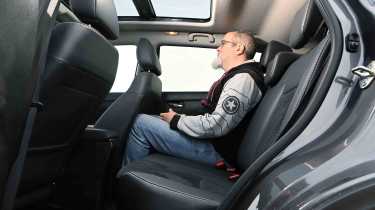
Boot space
There’s a false floor in the back of the Vitara that gives a level load area, but the storage underneath is only a few centimetres deep. There is room for a space-saver spare wheel beneath this, though.
The back seats fold in a 60:40 split with the press of a button on the shoulders of the seatbacks, and there’s a slight rise in the floor when they are collapsed. Other highlights in the boot include a 12-volt socket, while there are a couple of recesses behind the wheelarches for smaller items.

“A low load lip helps with lifting heavy items into the boot, but I found that the tailgate didn’t rise high enough, so I kept catching my head on the boot latch when it was fully open.” – Dean Gibson, senior test editor, tested the 2025 Vitara against the Mazda CX-30 in a twin test
Reliability & safety
| Pros |
|
| Cons |
|
While the Suzuki Vitara has earned a five-star Euro NCAP rating, it was tested in 2015, and this classification expired after six years. However, if the car were tested again, the latest round of safety additions could well see it earn a high score.
As well as adding driver-attention assist, lane assist and adaptive cruise control, the Vitara now features Suzuki’s Dual Sensor Brake Support. This is a new radar and camera-based set-up for the autonomous emergency braking system, which is claimed to be more sensitive to other road users, so it can better pick out cyclists and pedestrians, as well as being more effective at detecting hazards at night and at junctions.
| Key standard safety features |
|
| Euro NCAP safety ratings |
|
Buying and owning
- Best buy: Suzuki Vitara 1.4 Boosterjet Ultra
The hybrid model only offers marginally better fuel economy than the Boosterjet version, so unless you need the former’s automatic gearbox (although we’d recommend avoiding Suzuki’s one completely), the manual offers a better driving experience.
Suzuki owners are a loyal bunch, and while the company sells in relatively low volumes in the UK, there are enough fans of the marque out there to sing its praises. The 2024 Driver Power survey saw the company finish 19th out of 32 marques, beating some much bigger names in the process.
The Vitara comes with a three-year/60,000-mile warranty. However, Suzuki also offers a ‘service activated’ warranty that can cover the car for up to seven years or a total of 100,000 miles. Simply book a service at a Suzuki franchise, and 12 months of extra cover is added to the warranty. Those service intervals are scheduled for every 12,500 miles or 12 months, whichever comes first.
Suzuki Vitara alternatives
When the Suzuki Vitara Mk4 first arrived, there were a handful of rivals to choose from, but since then we’ve seen an explosion of the choice in the small SUV market. Our favourites in the class include the Renault Captur (a great-value all-rounder), Ford Puma (fun to drive), Mazda CX-30 (good to drive and a premium feel inside) and Toyota Yaris Cross (efficient hybrid powertrains). Elsewhere, the SEAT Arona, Volkswagen T-Cross, and Volkswagen Taigo share tech, while the Skoda Kamiq straddles a line between SUV and crossover, but is a very practical vehicle. Other options include the Citroen C3 Aircross, Vauxhall Mokka, Peugeot 2008 and Fiat 600, all of which use the same platform and powertrains, including all-electric, while the Hyundai Bayon and Kia XCeed and Kia Stonic are also worth considering.
Suzuki Vitara SZ5: long-term test
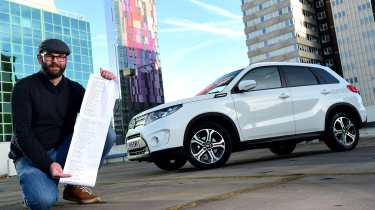
In 2016, our creative director, Darren Wilson, spent 10 months behind the wheel of a pre-facelift Suzuki Vitara in fully loaded SZ5 trim. His car came with a highly economical diesel engine that was available at the time, providing frugal motoring for 8,000 miles.
That being said, he found the engine noisy and agricultural. He also found that the interior quality wasn’t up to the class standard, and did, in fact, have some issues with loose trim during his ownership.
Frequently Asked Questions
It’s an okay choice, but there are plenty of alternatives that offer a better range of abilities. It has never been a class leader, but it offers a dependable and reliable driving experience, and its relatively light weight and sprightly engine mean it’s one of the better cars to drive in the class.
